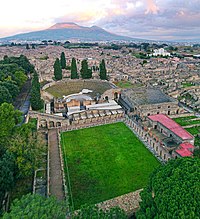
Photo from wikipedia
Abstract In this paper we provide a critical review of the studies conducted on the geology of Rome since the first half of the 20th century, aimed at presenting an… Click to show full abstract
Abstract In this paper we provide a critical review of the studies conducted on the geology of Rome since the first half of the 20th century, aimed at presenting an updated state of the art on the stratigraphy of this area. Following this introductory summary, we present a complete reconstruction of the geological evolution and the resulting chrono-litho-stratigraphic setting of the greater area of Rome, according to a series of works that in the last 20 years have adopted an innovative methodological approach based on the conceptual model of aggradational successions deposited in response to sea-level rise during the glacial terminations, and on the strict geochronologic constraints to the sedimentary record achieved by paleomagnetic investigation of clay sections and 40Ar/39Ar dating of interbedded volcanic materials. We also present a complete overview on the chronostratigraphy of the two volcanic districts of Colli Albani and Monti Sabatini, located SE and NW of Rome respectively, that has been achieved integrating the field work with the large number of radiometric ages provided in these years on their eruptive products. Moreover, we propose a revised stratigraphic column to compare the most recent official 1:50,000 and 1:10,000 geologic mapping of Rome, which is intended as a tool of correlation for an international audience of Quaternary scientists to approach the study of this area. A detailed discussion of the proposed revisions is also provided as supplementary information to this paper.
Journal Title: Quaternary International
Year Published: 2017
Link to full text (if available)
Share on Social Media: Sign Up to like & get
recommendations!